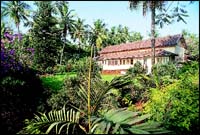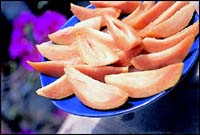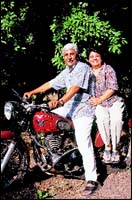


|
|
|
ROHINTON and Ruby Batliwala are Gholvad�s popular Parsi-Irani chikoo farmers. They live in a huge and rambling planter�s house a short distance away from the Gholvad Railway Station and zip about their vast chikoo wadi on an old 350cc Matchless motorcycle. Every evening during the season, trainloads of their chikoos depart from the station for Bombay, from where it enters the fruit and vegetable markets and goes up for sale. Earlier, the Gholvad and Dahanu chikoo farmers had three crops of the fruit every year. In November, April and September. Now, with environmental changes, which they blame upon the BSES� thermal plant on the Dahanu coastline, the chikoo season is unpredictable. This year, they have a crop in July! Elsewhere in the world, the chikoo is known as sapodilla, and the drab oval fruit traces its origin to Central America. India is said to have got the fruit from Spain. The chikoo taste, you know, resembles that of vanilla-flavoured banana custard. The ripe fruit has rough, light-brown skin outside; inside, the flesh is honey-coloured, sweet and luscious with a core containing inedible, hard black seeds. Ripe chikoos have wrinkled brown skin that gives slightly when pressed. The unripe fruit has smooth skin with a greenish tinge. Avoid this. Unripe fruit is full of tannin and the flesh is unpleasantly grainy and mouth-puckeringly unpalatable. Instead, leave the fruit to ripen for upto a week in a fruit bowl. Ripe chikoos can be kept in the fridge for upto a month.
Rohinton is one of the 50-odd Parsi-Irani chikoo farmers left in the area. He owns one of most prestigious chikoo wadis in Gholvad. And it was his great-grandfather, Cawasji Patel, who brought the first chikoo plant to Gholvad in 1920. This was from the Hanging Gardens in Bombay. His grandfather, Maneckshaw Cawasji Patel, developed the plant, and that�s how the Zoroastrians of Gholvad and Dahanu came to be chikoo farmers. The oldest chikoo tree is said to be 70-odd years old. Rohinton has been farming chikoos since he was 16. He talks about a Gholvad that never required air-conditioners or fans even in the peak of summer. The maximum temperature used to be 30 degrees C. Winters, it hovered around 12 degrees C. All that has however changed. Summer, which used to be only a month then and in May, now begins in February and ends in June!
As recent as ten years ago, these farmers sold their chikoos at rates of between Rs. 50 and 80 for baskets of 10 kg. About eight dozen chikoos came in that 10 kg. Now they get anything between Rs. 20 and 40 for 10 kg. The chikoos come in various sizes. the smallest sizes make 30 dozen per 10 kg. Apart from the dwindling rates, the farmers also face the problem of the �chikoo borer�, which is an insect that affects the trees big time. It either eats into the seed, flower or bark of the tree. If it eats the flower at a tender stage, the fruit does not form at all. If the insect eats the seed, the fruit becomes hard and rotten. And if it eats the tree, that is the end of that chikoo plant! The fruit is eaten just as it is, simply cut in half, and then the flesh is scooped out and the seeds discarded. The fruit can be mashed and stirred into cream or custard, or made into ice-cream, fools and mousses. Pureed chikoo with mayonnaise makes a good sauce for cold fish or chicken.
|

Home Page
About the mag
Subscribe
Advertise
Contact Us

 Chikoo Gholvad�s Wadis
Chikoo Gholvad�s Wadis
 It takes upto 12 years before a chikoo tree is ready to bear fruit that can be commercially sold. The chikoo fruit starts growing from the third year of the tree�s life but this is not fit for the table. The chikoo tree is a sturdy and rugged thing, it can survive in the harshest conditions, and does not need any special maintenance. At one time, the economy of Dahanu and Gholvad survived on the chikoo. Now the scene is dismal and alarming. Many of the Parsi-Irani chikoo farmers have migrated to other cities and different professions. And now there must exist not more than 50 of them in the coastal belt who continue farming chikoos. Incredibly, despite the environmental changes, the soil and climate, the proximity of the sea and mountains, still favour the growth of chikoos in Dahanu and Gholvad.
It takes upto 12 years before a chikoo tree is ready to bear fruit that can be commercially sold. The chikoo fruit starts growing from the third year of the tree�s life but this is not fit for the table. The chikoo tree is a sturdy and rugged thing, it can survive in the harshest conditions, and does not need any special maintenance. At one time, the economy of Dahanu and Gholvad survived on the chikoo. Now the scene is dismal and alarming. Many of the Parsi-Irani chikoo farmers have migrated to other cities and different professions. And now there must exist not more than 50 of them in the coastal belt who continue farming chikoos. Incredibly, despite the environmental changes, the soil and climate, the proximity of the sea and mountains, still favour the growth of chikoos in Dahanu and Gholvad. Despite the uncooperative environment and whimsical weather, the Irani-Parsi farmers are making a go of their chikoo wadis. They patiently wait for the six month gestation period between flower and fruit, when they might lovingly harvest the chikoo each year. The fruit is plucked by hand. They use a strange contraption for the job. It is a wire-basket on the end of a long stick. The trees are not very tall, they are about 15 feet, and the stick reaches upto the fruit and breaks it off the stem. The chikoos are washed and packed and then despatched to the local market and by train to Bombay. The Dahanu-Gholvad chikoos also go to Delhi, Jaipur and Udaipur, but not the South. At one time they were even being exported to Dubai.
Despite the uncooperative environment and whimsical weather, the Irani-Parsi farmers are making a go of their chikoo wadis. They patiently wait for the six month gestation period between flower and fruit, when they might lovingly harvest the chikoo each year. The fruit is plucked by hand. They use a strange contraption for the job. It is a wire-basket on the end of a long stick. The trees are not very tall, they are about 15 feet, and the stick reaches upto the fruit and breaks it off the stem. The chikoos are washed and packed and then despatched to the local market and by train to Bombay. The Dahanu-Gholvad chikoos also go to Delhi, Jaipur and Udaipur, but not the South. At one time they were even being exported to Dubai.